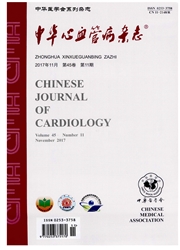

 中文摘要:
中文摘要:
目的 探讨平均血小板体积(MPV)和Gensini积分预测接受急诊经皮冠状动脉介入治疗(PCI)的急性ST段抬高型心肌梗死患者住院期间及术后6个月预后的价值.方法 连续入选2011年9月至2013年6月入院的接受急诊PCI的急性ST段抬高型心肌梗死患者102例.患者在入院即刻检查血常规,根据冠状动脉造影结果计算Gensini积分,并观察患者在住院期间及术后6个月发生的主要不良心血管事件(MACE).结果 发生MACE患者的MPV、Gensini积分、冠状动脉三支病变比例均高于未发生MACE患者(P<0.05或0.01).MPV联合Gensini积分预测住院期间发生MACE的受试者工作特征曲线下面积(AUC)为0.836(95% CI:0.706 -0.966,P=0.003),预测术后6个月发生MACE的AUC为0.718 (95% CI:0.571-0.866,P=0.006).Kaplan-Meier生存分析显示,术后6个月高MPV(> 10.65 fl)患者无MACE发生率低于低MPV(≤10.65 fl)患者(log-rank =4.272,P=0.039);Gensini积分高(>89分)患者无MACE发生率低于积分低(≤89分)患者(log-rank=7.355,P=0.007).结论 MPV联合Gensini积分对急性ST段抬高型心肌梗死患者住院期间和术后6个月发生MACE有较高的预测价值.
 英文摘要:
英文摘要:
Objective To explore the value of mean platelet volume (MPV) and Gensini score on predicting short-term prognosis of patients with acute ST segment elevation myocardial infarction (STEMI) post emergency percutaneous coronary intervention (PCI).Methods From September 2011 to June 2013,102 consecutive hospitalized STEMI patients undergoing emergency PCI were included.All patients routine blood test was made immediately after admission,and Gensini score was calculated according to the results of coronary angiography.Incidence of major adverse cardiac events (MACE) during hospitalization and 6 months after PCI was observed.Results MPV,Gensini score and percent of coronary artery three vessel lesions were significantly higher in MACE patients than in patients without MACE(P 〈 0.05 or 0.01).Area under the curve (AUC) of MPV plus Gensini score for predicting in hospital MACE and at 6 months post PCI was 0.836 (95% CI:0.706-0.966,P =0.003) and 0.718 (95% CI:0.571-0.866,P =0.006),respectively.Kaplan-Meier survival analysis showed that incidence of without MACE at 6 months post PCI was significantly lower in patients with high MPV (〉 10.65 f1)than in patients with low MPV(≤ 10.65 f1) at admission (log-rank =4.272,P =0.039),and in patients with high Gensini score (〉 89) than in low Gensini score(≤89) (log-rank =7.355,P =0.007) at admission.Conclusions High MPV and Gensini score are associated with lower MACE during hospitalization and at 6 months after PCI in acute STEMI patient.These two parameters could thus be used to predict short-term MACE in STEMI patients post PCI.
 同期刊论文项目
同期刊论文项目
 同项目期刊论文
同项目期刊论文
 Association between genetic polymorphism in NFKB1 and NFKBIA and coronary artery disease in aChinese
Association between genetic polymorphism in NFKB1 and NFKBIA and coronary artery disease in aChinese Acupuncture for Essential Hypertension: A Meta-Analysis of Randomized Sham-Controlled Clinical Trial
Acupuncture for Essential Hypertension: A Meta-Analysis of Randomized Sham-Controlled Clinical Trial Association of mean platelet volume with impaired myocardial reperfusion and short-term mortality in
Association of mean platelet volume with impaired myocardial reperfusion and short-term mortality in 期刊信息
期刊信息
